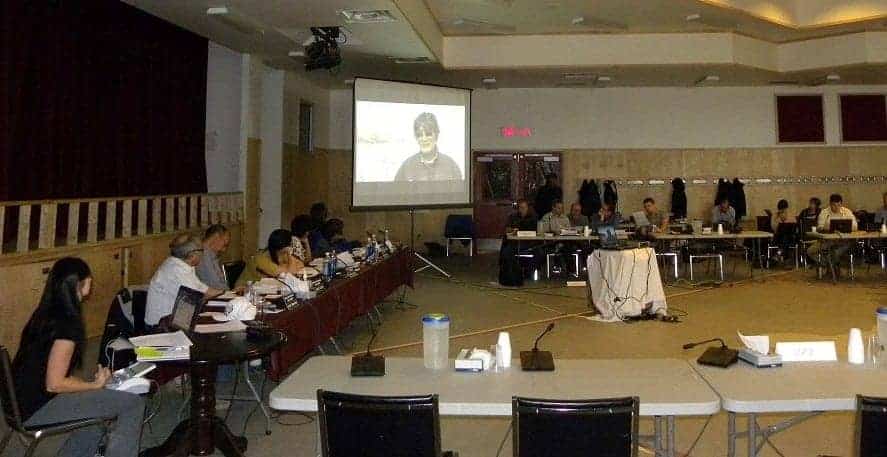The process leading to a public hearing scheduled for May 2019 on Baffinland Iron Mines Corp.'s Phase 2 development proposal for the Mary River mine continues, as public engagement sessions in communities are scheduled to take place in January.
Meanwhile, the period of time for commenters to submit technical questions to the company on its Final Environmental Impact Statement closed Nov. 23, following the release of the final draft for review Oct. 12.

As the Nunavut Impact Review Board heads toward a May 2019 public hearing for Baffinland Iron Mines Corp.'s phase 2 development proposal in Pond Inlet, community engagement sessions are set for January in the seven affected communities. Here, review board members listen to a presentation by Iglulik's Zacharias Kunuk at a previous public hearing for the Mary River mine held in Pond Inlet in 2016.
"We are not currently able to assess the adequacy of Baffinland’s efforts to improve upon the management of the current project. This raises serious questions about the appropriateness of a significant project expansion," stated Qikiqtani Inuit Association (QIA) executive director Jeremiah Groves in a cover letter dated Nov. 23.
Most recently, QIA supported – and lobbied the federal government on behalf of Baffinland – a production increase of ore to six million tonnes per year from 4.2 million tonnes despite the Nunavut Impact Review Board recommending against it. Federal approval for that increase came Sept. 30.
Of 12 organizations or government departments which submitted requests for additional information, the Qikiqtani Inuit Association (QIA) was the sole Inuit organization on the list. QIA's concerns range from Baffinland's performance to date, the scope of the phase 2 expansion, and process-related issues, specifically as relates to a proposed coordinated review by the review board and the Nunavut Water Board.
"QIA understands the intent of the Phase (2) proposal is to significantly increase the overall scope and scale of the Mary River Project. QIA is acutely aware that the Phase (2) proposal, if approved, would result in a potential mine with an annual production rate of up to 30 mpta (million tonnes per annum )," stated Groves
To put that into context, Baffinland announced Nov. 8 it had successfully shipped approximately 5.1 million tonnes of iron ore from its Milne Inlet port to markets in Europe, the United Kingdom, Taiwan, and Japan. Seventy-one voyages carried an average of 71,750 tonnes of iron ore each over 86 days.
The Phase 2 proposal would increase that amount six times over.
"The Phase (2) proposal includes two operational railways (north and south) two operational port sites (at Milne Inlet and Steensby), and two life of mine shipping routes (north and south) to support the annual production rate. The scope and scale of the Mary River project presented in the Phase (2) proposal will be a principal point of focus for QIA during the assessment process," stated Groves.
Overall, the Inuit organization expresses doubt the company can meet environmental and other obligations at that increased level of production, since it seems to have not met current obligations despite promises to do so.
Other commenters – government agencies both federal and territorial, and environmental groups – submitted hundreds of pages of questions and concerns.
Crown-Indigenous Relations and Northern Affairs Canada's first comment relate to inadequate baseline data.
"Having confidence in baseline data is necessary to identify and determine the significance of impacts that a proposed project will have on its biophysical and socio-economic environments, as well as the impacts that these environmental conditions will have on the project. As a result, the degree to which baseline data is adequate for the purposes of impact assessment is crucial," states the federal department about socio-economic impacts in a 22- page document..
"In the absence of a statement of adequacy of baseline data, it is difficult to assess the potential effects, residual effects and their significance …"
The Government of Nunavut, meanwhile, submitted 138 pages of comments related to inadequate information. Parks Canada, which works closely with Inuit on federal parks (Auyuittuq, Quttinirpaaq and Sirmilik) and Tallurutiup Imanga National Marine Conservation Area, expressed concerns related to ice management, shipping, and vessel management in Milne Inlet and Eclipse Sound.
In its submission, Health Canada stated there is insufficient information for the department to advise on effects related to country foods, air quality, noise, and drinking water.
Oceans North makes the point that uncertainty prevails with the Mary River mine.
"Over the course of the early revenue phase, Baffinland's ownership structure has changed, such that a majority interest is no longer controlled by a publicly-traded corporation. This has resulted in increased barriers to public information," stated Christopher Debicki, counsel and vice-president for policy development for the organization.
"In our view, this places a greater onus on the proponent to provide complete disclosure of risks and rewards as they pertain both to the existing terrestrial and maritime operations and to the expanded operations, as proposed."
All comments from the Qikiqtani Inuit Association, the Government of Nunavut, Crown-Indigenous Relations and Northern Affairs Canada, Environment and Climate Change Canada, Fisheries and Oceans Canada, Health Canada , Natural Resources Canada, Parks Canada Agency, Transport Canada, Oceans North and the World Wildlife Fund are available to the public on the review board's website.
The Nunavut Impact Review Board (NIRB) plans to be in Pond Inlet Jan. 14-15, Iglulik Jan. 16-17, Hall Beach Jan. 18-19, Resolute Bay, Jan. 21-22, Arctic Bay Jan. 23-24, Grise Fiord Jan. 25-26 and Clyde River Jan. 28-29.